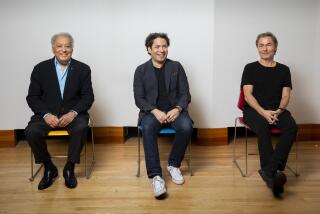ROGER BOBO: COMMITTED TO THE TUBA
Most adults probably wouldn’t get seriously upset over “Tubby the Tuba,” that popular musical narrative about an overlooked instrument that wants to stand out from the orchestral crowd.
But just mention the piece to Los Angeles Philharmonic tubist Roger Bobo and his bearded face assumes a pained expression.
“I fear that the piece is poignantly accurate,” he said, shaking his head during a recent interview. “I feel like I’m an extension of that character. There are some people who are satisfied to perform their function and go home. Then there are others who have this insatiable drive to go out and play solos--I fear I am one of those.”
A member of the Philharmonic since 1964, Bobo has played plenty of solos. He is performing John Williams’ Concerto for Tuba and Orchestra with the Philharmonic today at the Orange County Performing Arts Center, and Sunday and Wednesday at the Dorothy Chandler Pavilion. But he still projects a certain aura of discontent.
If the tuba player’s plight seems at first like an obscure symbol for man’s struggle against anonymity, then a visit to Bobo’s mountaintop home in Topanga offers a richer perspective.
“The tuba is my gift and my enemy, because I feel that I’m looked on as being a tubist and not a musician,” he said. It was Bobo’s longtime ambition to champion the tuba much as Jean-Pierre Rampal has the flute, achieving new dimensions of popularity for his instrument. Bobo, 48, said that while no tubist in the world makes a living as a solo virtuoso, his dream was to challenge that barrier, traveling as much as he could without leaving the Philharmonic.
In 1982, the musician sought as many solo engagements worldwide as he could, from Oklahoma to Iceland. But the going was tough.
“I tried. I went out 30 times to do solo work that year,” said Bobo, a large man running a large hand back through his thick, salt-and-pepper hair. He described the scheduling problems of a life devoted both to the orchestra--that “community of musicians” he says he greatly enjoys--and a soloist’s calendar.
“It is extremely fatiguing,” he said.
Also, most orchestras have their own tubists who crave their moment in the limelight. But Bobo says the biggest obstacle was a shortage of first-rate concert music that features the instrument.
“Rampal and (trumpeter) Maurice Andre have repertory problems, too, but they’re starting at a much richer spot than I am,” he said. “If I played the Vaughan Williams (tuba) concerto with an orchestra one year, there was the problem of the re-engagement for another concert. What would I play the next time? There isn’t much.
“That’s why this (John) Williams concerto is so important,” he continued.
“We’re fortunate to have the Vaughan Williams concerto. But in my opinion, it doesn’t hold a candle to this one . . . I think it’s one of the greatest concertos written for a brass instrument.”
Not everybody has agreed with him. Recalling last year’s Hollywood Bowl concert at which he gave the concerto its West Coast premiere, Bobo said, “I got better reviews for my performance than he did for the piece. I’m awestruck by one of the criticisms that there was nothing original in this piece.”
He said the Williams has an exceptional understanding of the tuba’s character:
“Obviously, the instrument can be a clown. It’s a wonderful monster. It can be a heavy-duty swashbuckler and it can also be a very romantic and lyrical instrument and the second movement of the Williams explores that tender side.”
The modern tuba took shape in the mid-1800s, becoming a popular band instrument; Wagner was the first major composer to use it in orchestras. In this century, the instrument has become particularly popular in Hollywood. In the movie “Close Encounters of the Third Kind,” for example, the monumental notes with which the space ship makes contact in the crucial mountaintop encounter were played on the tuba, though not by Bobo.
In six records Bobo has made and paid for himself, he tried to challenge the popular perception of the tuba as a novelty act or low-playing foundation of the brass section. The recordings include most of the 25 pieces, chamber music and unaccompanied works, commissioned out of his pocket or which composers have given him as gifts.
Bobo’s commitment to the tuba originated with an outsize instrument a teacher thrust into his hands at Eagle Rock High School and which he became increasingly serious about over three summers at the National Music Camp in Interlochen, Mich. While a freshman at the Eastman School of Music, he became the tubist of the Rochester Philharmonic. In 1962, he became tubist with the Concertgebouw Orchestra in Amsterdam before returning to Los Angeles two years later. He is the orchestra’s only full-time tubist.
Looking back, Bobo says he doesn’t regret taking up the tuba, instead of another instrument, but adds that the best moments are those when he transcends it.
“When I finish playing (the Williams concerto at the upcoming concerts), I want people to forget that I was playing the tuba and just think of it as music,” he said.
“It’s the peg-legged dancer syndrome. I don’t want to be the best peg-legged dancer around. I just want to be the best dancer.”
More to Read
The biggest entertainment stories
Get our big stories about Hollywood, film, television, music, arts, culture and more right in your inbox as soon as they publish.
You may occasionally receive promotional content from the Los Angeles Times.










